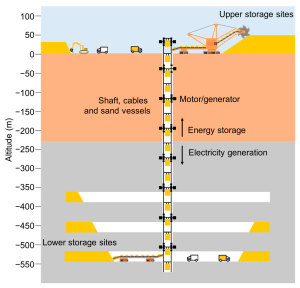1. One thing that helps
Are mines the future of sustainable energy? By conservative estimates, there are at least 50,000 abandoned mines in Australia and around 500,000 in the USA – with this number growing rapidly every day. Can “Underground Gravity Energy Storage” turn these from a blight on the earth, to an environmental energy solution?
The tech is pretty straightforward. We send sand-filled containers down an abandoned shaft fitted with electric generators. These generators use regenerative braking (familiar to those driving electric or hybrid cars) to transform the sand’s potential energy into electrical energy. The deeper and broader the shaft, the more energy is generated. After generating energy, the sand is sent back up to an upper storage site, waiting for their next trip down the mine shaft.

This allows grids to store power from renewables for a longer period of time compared to batteries. Unlike batteries that discharge over time, storing energy in sand is more stable. Think of the millions of abandoned mines waiting to be transformed into energy providers.
2. One to be wary of
AI needs data to train on. It can’t get enough. And it’s getting it any way it can. The primary method is web-scraping, where bots grab whatever is available off the internet – but sometimes it finds stuff it shouldn’t.
One artist who goes by the name Lapine found out that her private medical photos from ten years ago are being used to train AI. She made the alarming discovery using Have I Been Trained that allows artists to check whether their work has been used for AI training.
“In 2013 a doctor photographed my face as part of clinical documentation,” she explained on Twitter. “He died in 2018 and somehow that image ended up somewhere online and then ended up in the data set — the image that I signed a consent form for my doctor — not for a data set.”
Due to the nature of web scraping, it is difficult to pinpoint who’s responsible for the leak. It could be human error – the hospital may have not properly secured the photos uploaded to their database, or it could be bots getting too invasive for comfort. Ultimately the only thing we can do is ask questions about how our data is stored, be aware of the risks, and make informed decisions about those “terms and agreement” boxes we tick without reading.
3. One to amaze

I want to bat against Dennis Lillee. I want to try and return a Federer serve. I reckon I could catch a touchdown pass thrown by Patrick Mahomes.
Rapsodo and Trajekt Sports may be about to make my wish come true with their accurate pitching machines. Their technology allows them to accurately simulate the pitching style of a baseball player of your own choosing.
The devices can be trained by measuring the pitch as thrown in person, or by analysing tracking technology such as Hawkeye, which is used in major league baseball already. Ball-tracking technology measures speed, spin, movement and strike zone location that is then fed to the pitching machine to replicate.
This tech is already being used used by competing teams in training, although the vendor is very reticent to tell us who their clients are! It’s like a secret weapon used to prepare for the best pitchers in the game. But tech like this always filters down to the masses where you and I can finally play against our favourite player! Hold my beer. It’s my turn to bat.